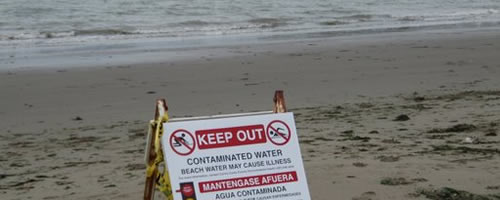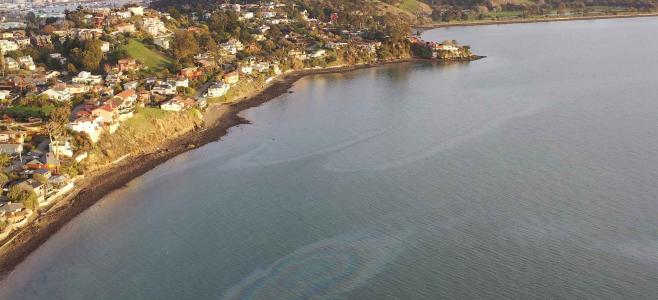
Five years ago on the morning of November 7, the 900-foot container ship Cosco Busan left Oakland, in heavy fog with low visibility. It side-swiped a Bay Bridge tower, ripping open two fuel tanks and pouring more than 53,000 gallons of heavy bunker fuel into San Francisco Bay.
Initially, the ship reported 400 gallons of oil had spilled. But a long plume of thick, floating bunker fuel quickly surged south of the bridge on the incoming tide. As the tide receded, the oil rushed out the Golden Gate, coating Baker Beach, Ocean Beach, and the north coast as far as Bolinas Bay. Oil soaked deep into Muir Beach sand and coated birds in Rodeo Lagoon. Then it streamed back into the Bay on the flood tide.
The morning of the spill, Baykeeper was on the water in our patrol boat, noting the edges of the spill and attempting to call in GPS coordinates so skimmers could make their way to the area before the plume spread throughout the Bay. But the official “oil hotline” for reporting oil remained defunct for more than two days, routing to a panicked secretary at the ship’s insurance company.
For the next several days, as the tides came in and out, oil ricocheted around the central Bay, leaving a suffocating oil ring along the shorelines of the East Bay, Richardson Bay, Alcatraz, and Angel Island. Public outrage mounted as media coverage showed oiled birds struggling in the surf and globs of oil coating beaches. Many who might have helped contain the damage complained of being shut out of the response, including city and park officials who weren’t notified before the spill hit their shorelines, as well as thousands of would-be volunteers.
Eventually, beach cleanup crews were deployed. But by the time on-the-water skimmers were on the Bay, and federal and state response teams were in full swing, most of the oil was too dispersed to be captured. Much of the damage to wildlife and sensitive habitats was already done.
How badly was the Bay impacted? Researchers surveyed species in various Bay habitats for signs of oiling and to assess their numbers; however, there was little data on the normal population levels of the many species that live in the Bay or stop here during migration.
We do know that at least six thousand birds were killed. Western grebes and surf scoters were especially hard hit. There was likely significant damage to the small creatures at the base of the Bay’s food chain. A generation of herring embryos was also wiped out, although last year’s huge herring spawn may indicate that the Bay’s last commercial fishery is rebounding.
Five years later, has the Bay recovered? It’s hard to know. While little research has been done to measure recovery by different species, our experience with other spills suggests that impacts may linger for decades.
Could a disaster like this happen again? There has been valuable progress in prevention and preparation—but more improvement is needed.
I served on the independent review panel that first evaluated the Cosco Busan response, and we created nearly 200 recommendations for preventing a similar spill and improving future response efforts. Since then, Baykeeper has worked to implement these recommendations by attending local oil spill planning meetings, participating in on-the-water drills, advising the state’s oil spill response agency, and helping develop key oil spill legislation in the California Legislature.
If another major spill happened, would sensitive shorelines be better protected? Baykeeper has invested a lot of effort to make sure the answer to this question “yes.” We supported six state oil spill bills signed into law in 2008 that mandated important changes. As a result, coordination among government agencies has improved—response officials now notify all local governments when a spill happens in the area. And many cities and park agencies now have personnel dedicated to oil spill response preparation who participate in regular drills.
But local oil spill response plans still depend on cleanup managers and crews being brought in from as far away as Texas. To serve as the shoreline’s first line of defense, local governments should be prepared to respond in the crucial first hours with equipment, staff, training, and volunteer plans.
In addition, a lack of funding threatens the state’s ability to rescue and care for wildlife during an oil spill. This year Baykeeper sponsored state legislation that would have filled this funding gap. Though the oil and shipping industry supported the necessary fee increase (less than a penny per barrel of oil), the Western States Petroleum Association killed the bill. Next year, as previous fees are phased out, the funding need will be even greater.
There is still much more to be done before the Bay Area is fully prepared to handle another disaster like the Cosco Busan spill. Five years later, Baykeeper remains steadfast in our work to assure that the Bay’s wildlife and shorelines are better protected from future oil spills.


